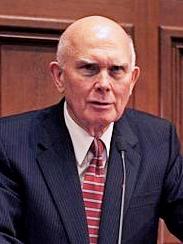
Dallin Harris Oaks is an American religious leader and former jurist and academic who since 2018 has been the first counselor in the First Presidency of the Church of Jesus Christ of Latter-day Saints. He was called as a member of the church's Quorum of the Twelve Apostles in 1984. Currently, he is the second most senior apostle by years of service and is the President of the Quorum of the Twelve Apostles.

Charles William Penrose was a member of the Quorum of the Twelve Apostles of the Church of Jesus Christ of Latter-day Saints from 1904 to 1911. Penrose was also a member of the First Presidency, serving as a counselor to church presidents Joseph F. Smith and Heber J. Grant from 1911 until his death.

The Church Educational System (CES) of the Church of Jesus Christ of Latter-day Saints consists of several institutions that provide religious and secular education for both Latter-day Saint and non–Latter-day Saint elementary, secondary, and post-secondary students and adult learners. Approximately 700,000 individuals were enrolled in CES programs in 143 countries in 2011. CES courses of study are separate and distinct from religious instruction provided through wards. Clark G. Gilbert, a general authority seventy, has been the CES commissioner since August 1, 2021.

Ernest Leroy Wilkinson was an American academic administrator, lawyer, and prominent figure in the Church of Jesus Christ of Latter-day Saints. He was president of Brigham Young University (BYU) from 1951 to 1971, simultaneously overseeing the entire LDS Church Educational System (CES). He is credited with the expansion of BYU. Under his presidency, the student body increased six times to over 25,000 students due to the university's physical growth and his aggressive recruiting policies; the number of colleges at the university increased from five to thirteen, and the number of faculty members increased four-fold. Wilkinson focused on recruiting more faculty and convincing current faculty to receive education outside the university. As a result, the number of teachers with doctorate degrees increased from 50 to 500. Associate and doctoral programs were created for BYU.

Benjamin Cluff Jr. was the first president of Brigham Young University and its third principal. Under his administration, the student body and faculty more than doubled in size, and the school went from an academy to a university, and was officially incorporated by the Church of Jesus Christ of Latter-day Saints. Cluff changed class periods from half an hour to a full hour, adopted the official colors of the university, started summer school and the Alumni Association, encouraged the university's first student newspaper, provided the first student loans, and developed an intercollegiate sports system.
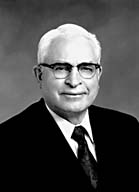
Hans Verlan Andersen was a general authority of the Church of Jesus Christ of Latter-day Saints and a professor at Brigham Young University (BYU).
The history of Brigham Young University (BYU) begins in 1875, when the school was called Brigham Young Academy (BYA). The school did not reach university status until 1903, in a decision made by the school's board of trustees at the request of BYU president Benjamin Cluff. It became accredited during the tenure of Franklin S. Harris, under whom it gained national recognition as a university. A period of expansion after World War II caused the student body to grow many times in size, making BYU the largest private university of the time. The school's history is closely connected with its sponsor, The Church of Jesus Christ of Latter-day Saints.

Neil Linden Andersen is an American religious leader and former business executive who serves as a member of the Quorum of the Twelve Apostles of the Church of Jesus Christ of Latter-day Saints. He was sustained by church membership as an apostle on April 4, 2009, during the church's General Conference. At the time of his call to the Twelve, Andersen had been serving as an LDS general authority since 1993, including service in the Presidency of the Seventy from 2005 to 2009. Currently, he is the ninth apostle in order of seniority in the church.
Joseph Taylor Bentley was the tenth general superintendent of the Young Men's Mutual Improvement Association of the Church of Jesus Christ of Latter-day Saints from 1958 to 1962.

J. Elliot Cameron was an American educator and leader in the Church of Jesus Christ of Latter-day Saints.
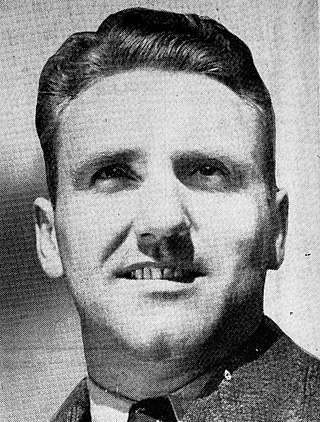
William Floyd Millet was an American football and basketball player, track and field athlete, coach of various sports, and college athletics administrator. Millet served as the head football coach at Brigham Young University (BYU) for one season in 1942, tallying a mark of 2–5. He was the head basketball coach at BYU from 1941 to 1949, compiling a record of 104–77. From 1963 to 1970, he served as the school's athletic director.
Edward Lawrence Kimball was an American scholar, lawyer, and historian who was a law professor at Brigham Young University (BYU).

Thomas Nicholls Taylor was an American businessman, politician and civic and religious leader. He was mayor of Provo, Utah, from 1900 to 1903.

The Brigham Young University (BYU) College of Fine Arts and Communications (CFAC) is one of the nine colleges at the university, a private institution operated by the Church of Jesus Christ of Latter-day Saints and located in Provo, Utah. Founded in 1925, the college has grown from a small college of the arts with minimal faculty and only 100 students to the second largest college on campus.
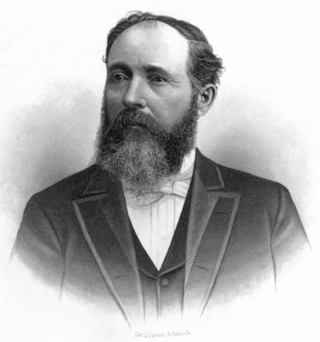
David John was a leading figure in Utah at the dawn of the 20th century. He served as a stake president in the Church of Jesus Christ of Latter-day Saints and a member of the Brigham Young University (BYU) board of trustees.

Thomas Earl Pardoe (1885–1971) was the first head of the Brigham Young University (BYU) drama program. One of the main theaters in the Harris Fine Arts Center at BYU is named for him and his wife, Kathryn Bassett Pardoe, who was also an influential drama teacher at BYU.

Brigham Young High School was a private high school in Provo, Utah, United States, first known as Brigham Young Academy (BYA). The school later became attached to Brigham Young University (BYU) with its official name being Brigham Young University High School, commonly called B Y High. It operated under the Church Educational System of the Church of Jesus Christ of Latter-day Saints.

The following outline is provided as an overview of and a topical guide to the Church of Jesus Christ of Latter-day Saints.
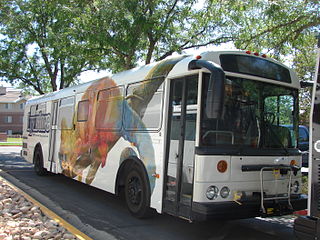
The Ryde is a bus service that provides transportation to the Brigham Young University (BYU) community in Provo, Utah, United States. The service is owned and operated by Student Movement, Inc. (SMI) and operates under the brand, "The Ryde". Although The Ryde began as a limited service paid shuttle bus, in the fall of 2015 it expanded to limited-service bus routes that are free to BYU students.

The David O. McKay School of Education (SOE) at Brigham Young University (BYU) specializes in teaching, administration, communication disorders, and educational inquiry. It is located in three buildings on BYU's campus in Provo, Utah, the David O. McKay Building, the John Taylor Building, and the George Albert Smith Fieldhouse. It was ranked number 84 in the United States for best education schools for 2021.
















